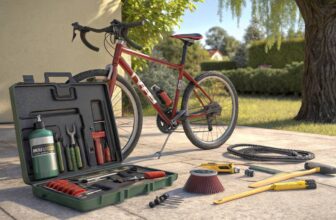Hybrid Bike Tire Features
Hybrid bike tires are a must-have for those who want the best of both city streets and light off-road trails. Getting to know the different aspects of these tires can guide you in choosing the perfect fit for your riding adventures.
Tread Types for Different Surfaces
The tread on your bike tire isn’t just about looks — it plays a big role in how your bike performs on different grounds. Hybrid bike tires offer a variety of tread patterns to suit a range of riding spots:
- Smooth Tread for City Riding: Best for paved surfaces, these tires slice through the streets with minimal resistance, making your ride smooth and speedy.
- Recessed Tread for Wet Conditions: Grooved to steer water away, these tires grip better and keep you safer when things get slippery.
- External Tread for Path and Trail Riding: Packed with grippy bits, they provide solid traction on dirt paths or gravel, so you won’t slip and slide.
| Tread Type | Best For | Surface |
|---|---|---|
| Smooth | City Riding | Paved Roads, Bike Paths |
| Recessed | Wet Conditions | Wet Roads |
| External | Path and Trail Riding | Dirt Paths, Gravel Roads |
Want to know more about picking a hybrid bike tire? Check out our hybrid bike components guide.
Puncture Protection Technology
No one wants to deal with a flat, especially when you’re out on a ride. That’s why modern hybrid tires come with some pretty neat puncture-busting tricks:
- Anti-Cut Sidewalls: These sidewalls are beefed up to shrug off cuts and scrapes from sharp stuff.
- Sub-Tread Breaker Belts: Hidden under the tire surface, these belts guard against pointy things trying to ruin your day.
- Robust Construction: A strong, multi-layer build means these tires can handle rough rides without falling apart.
| Feature | Description | Benefit |
|---|---|---|
| Anti-Cut Sidewalls | Reinforced Sidewalls | Protection Against Cuts |
| Sub-Tread Breaker Belts | Barrier Underneath Tire Surface | Defense Against Sharp Debris |
| Robust Construction | Multi-Layer Build | Increased Durability |
Need tips on avoiding flats and keeping those tires in tip-top shape? Check out our hybrid bike maintenance tips.
Hybrid bike tires usually rock the 700c size (that’s 622mm to the initiated), with widths between 35mm and 45mm. This flexibility lets you tweak your bike to match your commute through the city or weekend trail jaunt. Learn more in our piece on hybrid bike wheel size.
Knowing these features gives you the upper hand in choosing tires that’ll amp up your cycling fun. For more tire-talk, see how hybrid tires stack up against road bike tires or peek at how they compare to mountain bike tires.
Choosing the Right Hybrid Bike Tire
Picking the perfect tire for your hybrid bike can make all the difference between a smooth cruise and a bumpy ride. Let’s break it down so you can hit the road with confidence, plus a bit of style.
Tire Diameter and Width Options
When it comes to tire sizes, hybrid bikes give you a couple of options: the old favorite 700c and the trusty 26-inch.
700c Tires:
- These are your go-to guys with a standard size measuring 622mm around.
- You might see ’em labeled as 700Cx35 or 700x35C.
- Widths usually hang out between the 35mm to 45mm range.
- They’re speedy yet stable—kind of like a well-balanced breakfast.
26-inch Tires:
- Versatile champs that can handle almost anything.
- They offer a plush experience for those who prefer cushy rides.
Decoding those crazy numbers on your tire can feel like solving a math problem! Here’s the cheat sheet. The first digit is the diameter, the second is the width. So, a 700x35C tire means you’re dealing with 622mm of diameter and a slick 35mm of width.
Bontrager’s Tire Families
Bontrager’s got you covered with an impressive lineup designed to suit every rider’s needs. Whether you’re after speed, grip, or comfort, they’ve got something for you.
Bontrager H2:
- Perfect for the daily grind to work.
- Rolls like butter with great puncture protection—’cause nobody wants a flat on the way to the office.
Bontrager H5:
- These are your adventurers, made for mixed surfaces.
- The extra tread gives you better control and confidence.
Bontrager LT2:
- Ready for those weekend trial runs.
- Offers more grip and is tough enough for bumpy paths.
Not sold after the first spin? Bontrager’s got a sweet 30-day ride-and-return deal, so feel free to test-drive your way to the perfect pair.
| Tire Family | Ideal For | Features | Width Options |
|---|---|---|---|
| Bontrager H2 | Commuting | Smooth ride, low resistance, puncture-proof | 35mm – 45mm |
| Bontrager H5 | Mixed terrains | Extra tread for better grip & control | 38mm – 45mm |
| Bontrager LT2 | Light trails | Grip like a pro, built for rough stuff | 40mm – 50mm |
Do you have questions about hybrid bike geometry, bike sizing, or frames? Our site is crammed with info to help out. For tips on maintenance or nifty accessories, dig into our treasure chest of articles.
Components of a Hybrid Bike
Getting to grips with hybrid bike parts can make urban commuting and weekend rides a breeze. Let’s check out the wheels and gears, the dynamic duo of your biking experience.
Wheel Size Options
When it comes to hybrid bike wheels, you’ve mainly got two choices: 700c and 26 inches. Your pick will hinge on what kind of ride you’re after. Look at the tire’s sidewall—they’ll spill the beans on size. The first number is the diameter, and the second is the width.
700c Wheels:
- These are pretty much the default for hybrids.
- They measure up to 622mm in diameter.
- Tire widths usually float between 35mm and 45mm.
- Want speed and efficiency on smooth pavement? These are your wheels.
26-Inch Wheels:
- A more compact option for riders.
- Smaller wheels mean better control and maneuverability.
| Wheel Size | Diameter (mm) | Typical Tire Width (mm) |
|---|---|---|
| 700c | 622 | 35 – 45 |
| 26 inches | 559 | 35 – 45 |
Lighter frames and thin tires are the norm, with a nod toward speed and performance. Picking between 700c and 26-inch tires should match your style and the terrain you plan to conquer. Want the lowdown on sizes? Take a peek at our wheel size guide.
Gear Variations
The gear setup on hybrid bikes varies a lot, so you’re covered whether you’re coasting on streets or tackling hills. You could find a single gear or a mind-boggling 27.
Single-Speed Hybrid Bikes:
- They keep things simple with one gear.
- Great fit for flat areas and beginners who prefer an easy-breezy ride.
Multi-Speed Hybrid Bikes:
- These range from 7 to 27 gears.
- They handle a mix of inclines and surface types like a pro.
| Gear Range | Recommended Usage |
|---|---|
| Single-Speed | Flat terrains, beginners |
| 7-Speed | Urban commutes, moderate inclines |
| 21-Speed | Hilly terrains, diverse surfaces |
| 27-Speed | Advanced riders, challenging terrains |
Picking your gear depends on your fitness, the terrain, and what you want out of your ride. For the nitty-gritty on gears, don’t skip our gear guide.
Knowing your wheel and gear options can transform your cycling journey. Whether you’re after a zippy road experience or a flexible bike for mixed terrains, the right combo will nail it. More tips and tricks? Check out our article on hybrid bike features.
Braking System Choices
Deciding on a braking system for hybrid bikes is a biggie since it majorly impacts the safety and overall ride experience. Let’s break down the battle between rim brakes and disc brakes, checking their upsides and downs.
Rim Brakes vs. Disc Brakes
Hybrid bikes can either sport rim brakes or disc brakes. Both have their perks and quirks.
- Rim Brakes: These champs clamp onto the wheel rims, creating resistance to stop your bike. You’ll see them often on hybrid and road bikes. Folks like them for being straightforward and lightweight.
- Disc Brakes: Here, we’ve got rotors fixed to wheel hubs. They come in two blends: mechanical and hydraulic disc brakes. They’re famous for beefy stopping power, commonly found on mountain bikes, and catching on with hybrids.
For more bike component details, swing by our all-you-need-to-know guide on hybrid bike components.
| Feature | Rim Brakes | Disc Brakes |
|---|---|---|
| Stopping Power | Decent | Top-Notch |
| Maintenance | Easy | More Involved |
| Weight | Light | A Bit Heavy |
| Wet Conditions Performance | Drops | Stays Strong |
| Cost | Cheaper | More Pricey |
Pros and Cons of Disc Brakes
Knowing the good and not-so-good about disc brakes can seriously help in choosing well.
Pros:
- Mighty Stopping: Disc brakes pack a punch, perfect for those nail-biting downhill rides and quick stops (Retrospec).
- Weather Warrior: They don’t let rain or muck mess with their smooth operation, great for those who hit the trail all year round.
- Steady Eddie: With their braking surface tucked away from road gunk, they offer solid, dependable stopping action.
Cons:
- Chunky Weight: Disc brakes can weigh you down, something to think about if you’re racing the clock or going the distance.
- More TLC: There’s more fiddling involved to keep them working great. Hydraulic disc brakes, especially, might need a pro touch.
- Price Tag: Generally, bikes with disc brakes will take a bigger bite out of your budget due to their advanced design and materials (REI).
Picking the right brakes really boils down to your riding style, the terrain you’re tackling, and what ticks your boxes. For an encore of hybrid bike know-how, check our pages on hybrid bike frames and hybrid bike handlebars.
If you’re keen to know more about these choices, hit up our comprehensive guide on hybrid bike brakes.
Additional Accessories
Rocking some sweet accessories can take your hybrid bike journey from good to great. Here, we’ll shine a light on some must-haves—like fenders—and give you the lowdown on tire pressure to keep your rides smooth and safe.
Importance of Fenders
If you’re riding your hybrid bike in the city or through rainy days, fenders are like your bike’s best buds. They keep all that road gunk, puddle splashes, and stray debris from ruining your day and outfit (source: REI). This is gold for folks who want to hit the office without looking like they’ve been mud wrestling.
Perks of Fenders:
- Keeps your get-up spotless in soggy weather.
- Boosts safety by banishing water from your bike’s frame.
- Curb the mud and grit sprays for a comfier ride.
Though fenders are the go-to for commuting and errand-running, if the sun’s shining and you’re all about that lightweight life, you might skip them. Swing by our hybrid bike accessories page for more essential goodies.
Tire Pressure Recommendations
Getting the tire pressure just right is key to a ride that’s both safe and top-notch on your hybrid bike. Too low or too high can mess with your comfort, speed, and handling. Make it a habit to check your tire pressure before every ride or at least weekly, as weather changes can slowly let the air out (source: Rodalink).
Tire Pressure Basics:
- Hybrid Bike Tires: Keep between 50 and 70 psi for the magic number.
- Tubeless Tires: You can drop the pressure a bit, keeping punctures at bay while still riding high.
Adding some pounds to your load? No prob. Just jack up the psi by a tick (1 psi) for each 5kg over the base 70kg (source: Rodalink).
| Rider Weight (kg) | Tire Pressure (psi) |
|---|---|
| Up to 70 | 50-60 |
| 70 – 80 | 60-65 |
| 80 – 90 | 65-70 |
| 90+ | 70+ |
Avoid filling your tires below or beyond these numbers; you’ll dodge flat tires and keep your ride comfy and slick (source: Rodalink). Stick to these guidelines for peak performance and tire life. Need more know-how on keeping your hybrid bike in tip-top shape? Zip over to our hybrid bike maintenance guide.
Comparison with Mountain Bike Tires
Trying to pick between hybrid and mountain bike tires? No worries, we’ll break it down so you can pedal off with confidence. Here’s what you need to know about width, tread, and how these elements mess with speed and performance.
Tire Width and Tread Differences
Hybrid rides roll out with slimmer tires, ranging from 32mm to 38mm across. Why? A slick center tread helps you zoom over city streets, while tiny knobbies on the sides keep you steady when you hit the light trails (Retrospec).
Mountain bikes, are built for rugged action with chunkier tires about 53mm to 58mm wide. These bad boys grip dirt, mud, and rocky tracks with deeply cut treads designed for maximum bite and control, especially on steep slopes (Retrospec). Let’s be honest, when things get gnarly, you need those wider guys to feel like the king of the hill (Hycline).
| Tire Type | Width (mm) | Tread Type | Ideal Use |
|---|---|---|---|
| Hybrid Bike Tires | 32 – 38 | Smooth center with little side knobblies | City streets, light trails |
| Mountain Bike Tires | 53 – 58 | Heavily carved | Dirt paths, rocky hills |
Got mud? Mountain bike tires have wide gaps in the treads to toss that mud aside, keeping your grip firm and your ride smooth (Hycline).
Impact on Speed and Performance
Hybrid tires walk the line between fast and flexible. They’re made for less rolling resistance on pavement, letting you zip around like a breeze. Perfect for city folks and those weekend joyrides (Retrospec).
Go for mountain bike tires and you’re talking higher rolling resistance, so they may not win speed medals on tarmac. But hit the wild outdoors, and you’re in for a controlled ride that eats up rough terrains, thanks to their extra grip (Retrospec).
| Tire Type | Rolling Resistance | Speed on Pavement | Off-road Skills |
|---|---|---|---|
| Hybrid Bike Tires | Low | Quick | Decent |
| Mountain Bike Tires | High | Slow | Great |
Choosing your tires boils down to where you’ll be riding. For asphalt and light trails, hybrids are your friend, blending speed with ease. Planning some backcountry trekking? Mountain tires got your back with the grip and balance you need.
Want more? Check out hybrid bike components, dive into hybrid bike accessories, and learn tricks to keep your hybrid ride in top shape.
Hybrid Bike vs. Road Bike Tires
Picking the right tires for your ride is key. It’s about balancing speed, comfort, and the terrain you tackle the most. Here’s a friendly look at how hybrid and road bike tires measure up.
Performance on Smooth Roads
When you’re looking to zip down a smooth roadway, road bikes tend to steal the show. Here’s why:
- Tire Style: Those skinny tires on road bikes (think 23mm to 28mm) are all about cutting through the air like a hot knife through butter. Minimal friction means once you’ve got momentum, you’re pretty much flying. Check out SixThreeZero for more insights.
- Weight of the Frame: These bikes are built light, so you get nimble speed without breaking a sweat.
- Riding Style: With those droopy handlebars, the air just glides right past you, making every ride feel like you’re channeling your inner Tour de France contestant.
| Feature | Hybrid Bike Tires | Road Bike Tires |
|---|---|---|
| Tire Width | 35mm – 45mm | 23mm – 28mm |
| Frame Weight | Middle of the road | Featherweight |
| Riding Style | Sit up and smell the roses | Aero and go |
Curious about speed? Check out our deep dive on hybrid bike speed.
Comfort and Riding Position
Feel like soaking up the scenery or just cruising comfortably? Hybrid bikes have you covered:
- Wider Tires: With tires ranging from 35mm to 45mm, these bikes keep things cushy. They’re perfect for cruising everything from bumpy city streets to dirt paths. For details, see SixThreeZero.
- Sitting Pretty: An upright ride means your back stays happier longer. Plus, you’re at just the right height to catch all the sights and sounds.
- Versatility: These babies are the Swiss Army knife of bikes. Great for commuting, playing, or just having a bit of laid-back fun, on pretty much any surface.
Check out our detailed look at the hybrid bike position and see why these bikes feel like a dream for all-day rides.
So, what’s your riding style telling you? Whether you’re gunning for speed or savoring the journey, knowing how hybrid and road bike tires play into your cycling adventures makes picking the right set a breeze. Dig into more about bike nuances with our article on hybrid bike geometry. Let’s get rolling!
Speed Comparison between Bike Types
Deciding between different bike styles? Gettin’ the low down on how hybrid bikes stack up against others like road bikes and mountain bikes is key for folks who zip around town, enjoy a leisurely weekend pedal, or kick off a fitness journey. How fast a hybrid bike goes, shifts based on parts and conditions, especially when put alongside road and mountain models.
Factors Influencing Speed
So, what makes one bike zoom and another crawl? Here’s what revs up or slows down your hybrid ride:
- Frame Weight: Hybrid bikes hit a sweet spot, not as hefty as mountain beats, but a tad bulkier than those sleek road racers.
- Tire Type: Those tires gotta handle it all—less chunky than mountain tires for smoother rolling, but wider than road versions for grip.
- Handlebar Style: Hybrids rock flat bars for comfy cruising; road bikes, meanwhile, push you forward with their drop bars.
- Suspension: Most hybrids skip the bouncy bits, letting all your pedaling power go right into the wheels.
- Riding Position: You’re sittin’ pretty and comfortable on a hybrid, which is great for chill rides but won’t cut through the wind as fast as a road bike.
Overall Speed Performance
Here’s a sneak peek at how hybrid bikes line up against their tougher and faster cousins:
| Bike Type | Average Speed (mph) | Terrain Suitability | Key Features |
|---|---|---|---|
| Hybrid Bike | 12-18 | Multi-surface | Not-so-heavy frame, multi-use tires, comfy ride position |
| Mountain Bike | 8-12 | Off-road, trails | Strong frame, grippy tires, shock absorbin’ bits |
| Road Bike | 15-22 | Smooth roads | Featherlight frame, slim tires, low and fast posture |
Sources: Retrospec, SixThreeZero
Got varied paths to conquer and that city commute to tackle? Hybrids are a perfect middle way for hybrid bike commuting and multi-surface joyrides. But if you’re all about shaving seconds on smooth roads, road bikes’ sleek frames and aerodynamic postures are unmatched. For rugged tracks, mountain bikes with their tough frames and suspension rule.
Knowing these bits will steer you toward the perfect bike to match how fast and fierce you wanna go!




